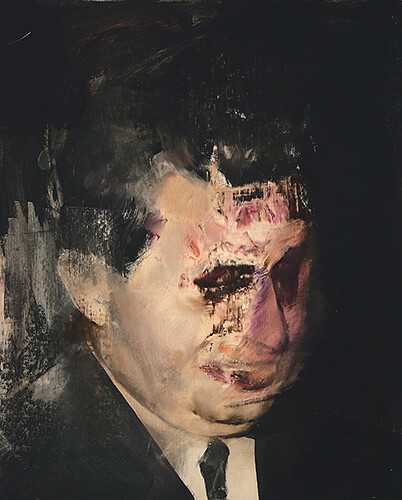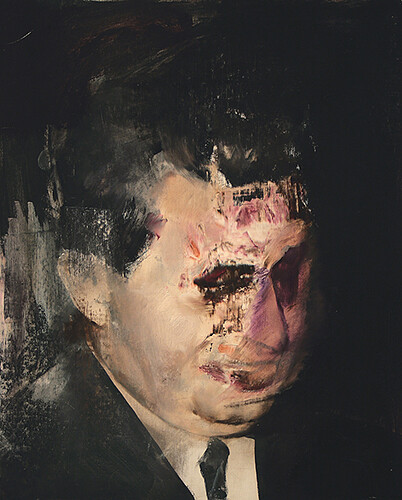Eastern European melancholia has a residual effect in the post-Communist era. To the Western capitalist-bred outsider, it’s a palpable element in a contemporary artistic milieu that grapples with traumatic memories. Take a stroll though the Vienna flea market—with its leftover household porcelain bric-a-brac, faded Stalinist era postcards, and propagandistic souvenir trinkets—and you’ll know what I mean.
Vienna has a particularly strong contextual and historical insight into the psyche of its Easterly inhabitants. Paid for by the hefty purse of the municipal cultural arm of the city, the initiative called “curated by_vienna” invited local galleries to organize shows by independent and institutional curators. Their mandated framework on Eastern European integration “East by Southwest” offered such specialist curators a discursive platform. (Turkey was included as a historical pivot point between east and Occident and its on-going flirtation with joining the union.)
In the few shows I saw, leitmotifs abounded: folk legend and superstition, historical marginalization, religious and cultural identity, borders and mapping, linguistic differences, research-based works, and postcolonial discourse were threaded together in the alienated Pop vernacular of 2011.
At Kerstin Engholm, Adam Budak delivered a tightly focused project on the Trans-Caucasus and Eurasia. This has particular resonance today due to the oil pipelines running through its various terrains. Slavs and Tatars anchored the show with The Library of Equivocation (2011), a doublewide kilim-covered platform with a surrounding rack of fascinating books such as Tattooed Mountain Women and Spoon Boxes of Dagestan and Gurdjieff’s Beelzebub’s Tales to His Grandson. A shelf of imaginary books arranged by Agnieszka Kurant was appropriated from descriptions found in novels (such as Borges). With sweet irony, their jacket covers had titles such as Where God Went Wrong and The Culinary Dostoevsky. Her thermo-chromic prints (that in theory disappear under light) Fata Morgana, Map of Phantom Islands (2011) and the Political Map of Phantom Islands (2011) show Atlantis and Lemuria reappearing in the same sea with California turned into an island. Suggesting futuristic “what if” scenarios, color-coded bars represent a roster of old world colony powers divvying up the new centuries spoils. Enhancing the conceptual positions with bravura painting, Armen Eloyan contributes lugubrious expressionistic Pop paintings that satirize military and folk portraiture.
Weird social realism with Pop inflections and black humor highlighted Ami Barak’s ironically titled “Communism Never Happened” at Charim Galerie Wien. Three dreary propagandist industry photos appropriated by Calin Dan (Communism As Anal Something, 2008-2011) were turned into a single triptych with cheery Pop-colored borders and decorative motifs. In front of a large round mirror, Victor Man placed a yellow coat rack holding three moth-eaten topcoats with the Romanian flag stitched into their linings. Stand in front of this theatrical tableau The Coats (2007) and you become the composite portrait of an underpaid Communist era bureaucrat. Adrian Ghenie’s large-scale portrait of Ceausescu, Study for a Boogeyman (2010), reminds you that real boogeyman do exist in the guise of recently gone but not forgotten Eastern Bloc dictators. Ioana Nemes’s Cuckoo’s Day, The Gate (2009) is a white plastic bas-relief based on the masks worn by young men to celebrate pagan holidays, ritualistically causing mayhem in calling forth village spirits. Who says folkloric superstition and pagan Gods are a thing of the past?
Gallery Nova, Zagreb, was founded in 1975 and its early activities reappear in archival ephemera and documentary material at Georg Kargl. The installation curated by Ana Janevski emphasizes the connective threads of Nova’s current day activities rather than a nostalgic retrospective. In their own heady words it’s about the contemporary “lack of discourse on national history, lack of an art market, and no official institutional valorization.” A highlight is the visually arresting 35mm color film Encounter (1963) by Vladimir Petek (1940-2003). This fragmentary portrait of a modish young woman posing in front of a brick wall is enhanced through physical interventions (scraping and animated color modulations) on the celluloid. Where experimental film is concerned, Petek, a member of audio-visual collective FAVIT group, is a nice discovery as Zagreb’s answer to 60s pioneers Stan Brakhage and Michael Snow.
In the modest show “What about this,” quirky artist curator Raimundas Malašauskas made the trip to Galerie Andreas Huber worthwhile by including a documentary video by Alain Della Negra and Kaori Kinoshita. The duo traveled to the creepy Astana, Kazakhstan (strategically situated between Russia and China), to shoot a documentary about the World Forum of Spiritual Culture. Billed as the world’s first newly built 21st century capital city, the forum is organized by Kazakh’s oil-rich government. It’s a triennial symposium for a congress of world religions that includes NGO’s, UFO “abductees,” and new age alternative communities all under the roof of a pyramid building designed by Lord Norman Foster and partners. What’s crepuscular about the whole affair is the invisibility of anything resembling historical or traditional Kazakh cultural signposts: that is to say, in brief, Astana is a new age Vegas.
Throughout the 21 exhibitions of “curated by_vienna,” anomalies of outmoded systems and estrangement from cultural mooring were in evidence. None were spookier than Daniel’s Knoor’s solo “Dead Letter Office|” as organized by Adam Szymczyk at Nächst St. Stephan Rosemarie Schwarzwälder. Allusive links were made to Hellenism, Eastern folklore, and 21st century technological surveillance. The front gallery foregrounds the impression of disconnected cultural signifiers with a roomful of matryoshka dolls fabricated from paper mâché and hand painted in grisaille by the artist himself. A set of the “missing arms” of the Venus de Milo—Carrara marble, no less—were placed in the window sills, and in another room a remote controlled red light sensor could be switched on and off from anywhere by the artist upon waking and sleeping. A floor plan of the Kunsthalle Basel, altered to form the shape of a pistol, is actually a mapping of the visitors who were scanned by covertly installed machines as they meandered around the well-appointed rooms. The security firm subcontracted to create the algorithmic footage used top-secret proprietary software to enable the sensor mechanisms to function in real time.
At “curated by_vienna,” one could discover unsung heroes of the 1960s, 70s and early 80s avant-garde juxtaposed with known quantities disseminated through the international biennial and gallery circuit. The initiative also proves that the commercial gallery system (read: market) and the institutional imprimatur go hand in hand, laying to rest any contextual issues about both models. Coinciding with the revamped but still tepid Vienna Art Fair, and the novel Fruits, Flowers, & Clouds art fair put forth by the Spike Art Quarterly mafia at the MAK, it was typically an overdose of exhibitions and glass shattering cocktail parties.








